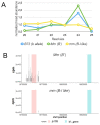AGO104 is a RdDM effector of paramutation at the maize b1 locus
- PMID: 36040902
- PMCID: PMC9426929
- DOI: 10.1371/journal.pone.0273695
AGO104 is a RdDM effector of paramutation at the maize b1 locus
Abstract
Although paramutation has been well-studied at a few hallmark loci involved in anthocyanin biosynthesis in maize, the cellular and molecular mechanisms underlying the phenomenon remain largely unknown. Previously described actors of paramutation encode components of the RNA-directed DNA-methylation (RdDM) pathway that participate in the biogenesis of 24-nucleotide small interfering RNAs (24-nt siRNAs) and long non-coding RNAs. In this study, we uncover an ARGONAUTE (AGO) protein as an effector of the RdDM pathway that is in charge of guiding 24-nt siRNAs to their DNA target to create de novo DNA methylation. We combined immunoprecipitation, small RNA sequencing and reverse genetics to, first, validate AGO104 as a member of the RdDM effector complex and, then, investigate its role in paramutation. We found that AGO104 binds 24-nt siRNAs involved in RdDM, including those required for paramutation at the b1 locus. We also show that the ago104-5 mutation causes a partial reversion of the paramutation phenotype at the b1 locus, revealed by intermediate pigmentation levels in stem tissues. Therefore, our results place AGO104 as a new member of the RdDM effector complex that plays a role in paramutation at the b1 locus in maize.
Conflict of interest statement
The authors have declared that no competing interests exist.
Figures




Similar articles
-
Maize RNA PolIV affects the expression of genes with nearby TE insertions and has a genome-wide repressive impact on transcription.BMC Plant Biol. 2017 Oct 12;17(1):161. doi: 10.1186/s12870-017-1108-1. BMC Plant Biol. 2017. PMID: 29025411 Free PMC article.
-
RNA-mediated trans-communication can establish paramutation at the b1 locus in maize.Proc Natl Acad Sci U S A. 2010 Jul 20;107(29):12986-91. doi: 10.1073/pnas.1007972107. Epub 2010 Jun 29. Proc Natl Acad Sci U S A. 2010. PMID: 20616013 Free PMC article.
-
MSI4/FVE is required for accumulation of 24-nt siRNAs and DNA methylation at a subset of target regions of RNA-directed DNA methylation.Plant J. 2021 Oct;108(2):347-357. doi: 10.1111/tpj.15441. Epub 2021 Aug 21. Plant J. 2021. PMID: 34314526 Free PMC article.
-
RNA-directed DNA methylation and demethylation in plants.Sci China C Life Sci. 2009 Apr;52(4):331-43. doi: 10.1007/s11427-009-0052-1. Epub 2009 Apr 21. Sci China C Life Sci. 2009. PMID: 19381459 Free PMC article. Review.
-
Paramutation: a process for acquiring trans-generational regulatory states.Curr Opin Plant Biol. 2011 Apr;14(2):210-6. doi: 10.1016/j.pbi.2011.02.005. Epub 2011 Mar 17. Curr Opin Plant Biol. 2011. PMID: 21420347 Review.
Cited by
-
Barley AGO4 proteins show overlapping functionality with distinct small RNA-binding properties in heterologous complementation.Plant Cell Rep. 2024 Mar 13;43(4):96. doi: 10.1007/s00299-024-03177-z. Plant Cell Rep. 2024. PMID: 38480545 Free PMC article.
-
Paramutation at the maize pl1 locus is associated with RdDM activity at distal tandem repeats.PLoS Genet. 2024 May 30;20(5):e1011296. doi: 10.1371/journal.pgen.1011296. eCollection 2024 May. PLoS Genet. 2024. PMID: 38814980 Free PMC article.
-
Transcribed enhancer sequences are required for maize p1 paramutation.Genetics. 2024 Jan 3;226(1):iyad178. doi: 10.1093/genetics/iyad178. Genetics. 2024. PMID: 38169343 Free PMC article.
-
Preliminary Evidence of a Horizontal Transfer of Paramutation Phenomenon at the pl1 Gene in Maize (Zea mays L.).Plants (Basel). 2024 Dec 24;14(1):11. doi: 10.3390/plants14010011. Plants (Basel). 2024. PMID: 39795272 Free PMC article.
References
Publication types
MeSH terms
Substances
Grants and funding
LinkOut - more resources
Full Text Sources
Research Materials

